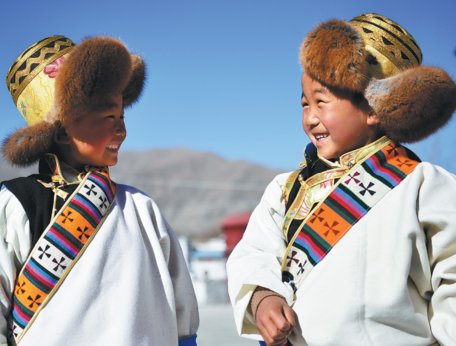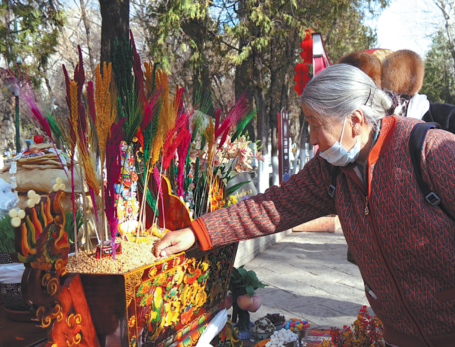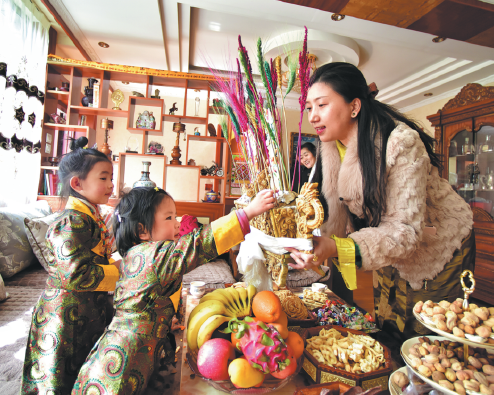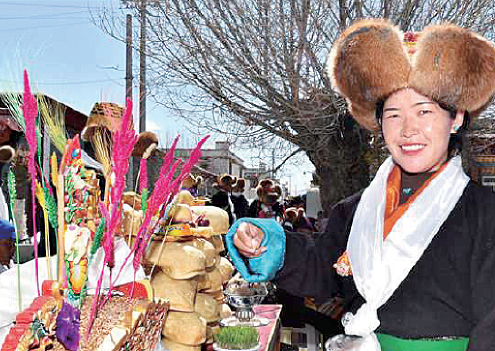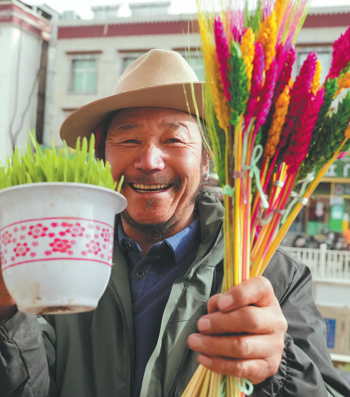Losar celebrations ring across Xizang autonomous region

Residents joyfully welcome the coming of Tibetan New Year with widespread festivities
Wearing traditional clothes, eating traditional food like guthuk stew, putting on spring couplets, raising prayer flags and setting off fireworks, residents in many areas of the Xizang autonomous region rejoiced with the coming of Tibetan New Year.
Residents in the autonomous region began to celebrate their New Year, or Losar as they call it, on the first day of the Tibetan calendar's first month, which fell on Feb 28 this year. The celebration lasted about two weeks.
An occasion for family reunion, Losar is the most important of all the traditional festivals in Xizang. It is also a grand showcase of the culture and traditions unique to this plateau region.
Tashi Gyatso, in his 70s, is a resident in Chengguan district of Lhasa, the capital city of Xizang. His neighbors affectionately call him a "living guidebook of Losar celebrations" for his seven decades of experience celebrating the event. He's always asked for advice on how to prepare for and spend the festival.
"Preparations can start two months before Losar New Year," Tashi Gyatso said. "Early winter is the best time to make dried yak meat, the staple food for Losar."
Tashi Gyatso himself did exactly that just months before the festival. "I bought two yak legs to make dried meat, which should be enough for my whole family during the period."
When the dried meat was ready, it was time to purchase various New Year goods. "Butter, milk, brown sugar, highland barley wine, khapse and a cherma box are must-buy items on my New Year goods list," Tashi Gyatso said.
Khapse is a type of snack similar to a deep-fried stick or twist, made of flour and yak milk butter.
"In the past, khapse was usually made by housewives," Tashi Gyatso said. "But now, there are plenty of khapse snacks in shops, giving an option to people who are too busy to make it on their own."
Cherma boxes also top the shopping list, Tashi Gyatso said. A cherma box is a container of items with symbolic and auspicious meanings. Its exterior is decorated with colorful patterns and images.
"Three things are standard with a cherma box: losar metog flowers; fried highland barley grains; and tsampa, or roasted barley flour," the old man said.
Losar metog, which Tashi Gyatso said is "the most beautiful flower in the world", is a kind of ornamental flower made of barley branches and ears dyed with bright and multiple colors.
"A cherma box is usually divided into two sections, each containing fried barley grains and tsampa. And losar metog flowers are arranged in both sections," Tashi Gyatso said. "All these things are symbols of good harvest and good luck."
While the first day of Losar is devoted to family reunions, residents then begin to visit relatives or friends in the following days. They greet each other with "Losar, Tashi Deleg", or "Happy New Year".
The visitors are first welcomed by a senior host who holds a cherma box. Guests take out some fried grains and tsampa, throwing some into the air and then putting the rest into their mouths.
"On the third day, we erect a prayer flag pole on the roof of the house and raise the flags, which marks the renewal of our hopes for the new year," Tashi Gyatso said.
He most appreciates the richness of rituals and their symbolic meanings during the Losar New Year celebration. "That's a tradition of a millennium, which always makes us proud of our culture and history," Tashi Gyatso said.
During the Losar New Year period, locals flocked to markets to make purchases for the celebrations. Stalls selling dried yak meat, yak butter, handmade pastries, candies, dried fruits and prayer flags have mushroomed everywhere.
The Barkhor market in Lhasa, for instance, was packed with shoppers eager to clinch a good deal during the monthlong annual Losar shopping festival.
"Despite the presence of other markets, Barkhor remains a popular spot for its vibrant atmosphere and diverse offerings," Champa Tsering, who is in charge of the market, told the local media.
This year, the Losar shopping festival highlighted an exhibition and sales of imported goods, attracting 30 merchants from South and West Asia. Exotic items such as hand-woven Nepali carpets and traditional Bhutanese handicraft were up for grabs during the event.
On Losar New Year's Day, the village of Kheme in the city of Lhokha was also in a festive atmosphere with flying prayer flags and other auspicious ornaments.
Tsewang, a primary school teacher in his 50s, walked along the street near his home. He met his friends and neighbors with the typical Tibetan greeting of "Tashi Deleg".
His home behind him was filled with the fragrance of Tibetan incense. With the sun shedding light on the flowers on the window sills, the rooms seemed bright and warm. In the kitchen, his wife was preparing New Year food and snacks, ready to welcome visiting guests.
When recalling the dozens of Losar celebrations over the past decades, Tsewang said that he loves its rich traditions and rituals, as well as the steady improvements in quality of life that can be seen in the celebrations.
"When I was a child, Losar was a long-awaited occasion, as it meant a wonderful opportunity to wear new clothes and eat big meals," Tsewang said. "And in the years since, we have become less concerned with material supplies because the supplies have been sufficient all year round. This allows us to get to the roots of the traditions that have been here for more than a millennium."
"Many traditions and rituals, such as presenting cherma boxes to guests and erecting prayer flags, embody the values of the good and kind," Tsewang added. "These traditions are worthy of being passed down to future generations."
He added that he is happy that his two children have grown up well. His daughter became a civil servant and his son became a teacher after they both graduated from university.
"Losar marks a farewell to the past and the beginning of a brand-new future," Tsewang said. "I hope our lives will become better and better."
Losar is celebrated on different days in different parts of Xizang due to variations in altitude and the harvesting season.
While most people celebrate Losar on the first day of the first month in the Tibetan calendar, residents in many parts of Shigatse and Nagchu celebrate it at the start of the 12th month, some in Ngari celebrate it in the 11th month, and people in eastern Nyingchi mark it as early as in the 10th month.
